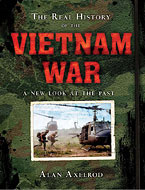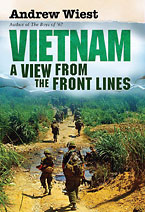 |
|||||||||||
|
Books in Review, May/June 2013 The History Of The Vietnam War: REVIEWS BY MARC LEEPSON
Which brings us to Alan Axelrod’s The Real History of the Vietnam War: A New Look at the Past (Sterling, 371 pp., $24.95). The mega-prolific Axelrod (he’s written “over eighty books,” his publisher says) never explains precisely why his work amounts to the “real history” of the Vietnam War. He offers a quote from Michael Lind, the author of Vietnam: The Necessary War, that “Americans want ‘real’ wars like World War II and the [first] Gulf War, not limited wars like Korea and Vietnam.” After pondering that, I thought Axelrod perhaps should have titled the book The History of the Real Vietnam War or The History of the “Real” Vietnam War. Axelrod goes on to say that it is “hard” to write “a single-volume, comprehensive ‘real history’ of the Vietnam War—a war with objectives that were not only limited but also highly questionable, often morally repugnant, and finally tragic; a war that never seemed ‘real’ (unlike World War II) yet was real enough to kill 58,272 Americans and at least two million Vietnamese.” The Lind quote, and Axelrod’s riff on what is real and what is not, still didn’t answer my literal question, however. As I searched for other clues, I read that Axelrod is the author of three other “real histories”—of the American Revolution, World War II, and the Cold War. All also have the same subtitle as his latest book: “A New Look at the Past.” Since there is little new in this book, I had to conclude that the whole “real history” business is merely a marketing ploy. That said, Axelrod has done a fine job in this one-volume history of the Vietnam War. It’s a concise, readable textbook-sized book, filled with facts and statistics (albeit without attribution). It, in fact, physically resembles a 21st century textbook for an abbreviated high school or college course on the war. It has snappily written chapter introductions in magazine-like large type and subhead-studded text, augmented with lots of reader-friendly photographs, sidebars, maps, and pull quotes. Focusing on military operations, tactics, and strategy, the book covers virtually every important aspect of the Vietnam War, including its political and geopolitical dimensions. And while it contains nothing that is new, Axelrod gets just about everything right, including his sections on home-front issues. That includes Axelrod’s on-the-mark presentation on what happened to America’s veterans when they came home from the war. Among “the most culturally and emotionally wrenching of the war’s effects on American society and culture,” he writes, “was a persistent view of the Vietnam vet as a combination victim and psychopathic fiend.” The Vietnam veteran, he says, was “too often shunned or assumed to be damaged goods—emotionally shattered, psychologically warped, quite possibly a drug addict, and almost certainly no longer fit to make a productive contribution to civilian society.” Movies, “television, and popular fiction greatly exaggerated and stereotyped the condition of the burned-out vet, no longer fit to live in civilized society, a danger to himself and others, a man whose only professions were criminality and killing.” This completely false “stigma,” he correctly notes, “remained firmly embedded for years, even after [the war ended in] 1975.” I found two fairly significant mistakes in this long book. In a “Reality Check” sidebar called “Feeling vs. Fact,” Axelrod mentions the “mistaken popular impression” that “draftees bore the brunt of the fighting in Vietnam.” That is technically correct, since something like two thirds of the 2.8 million men and women who served in Vietnam joined the military. But that doesn’t take into consideration the huge mitigating fact that enormous numbers of those who joined the Army, Navy, and Air Force did so to choose their military job rather than take a chance with the draft. Astute observers of the American war in Vietnam know that even though the number of enlistees who served in Vietnam far outnumbered draftees, untold hundreds of thousands of men never would have joined the military had there not been a draft to avoid. In that same sidebar Axelrod comes up with this preposterous statement: The “Army far preferred to deploy volunteers to the frontline units in the belief that volunteers naturally made better combat soldiers.” Where on earth did that come from? Since no source is listed, we will never know. The truth is that during the height of the Vietnam War the Pentagon was so desperate for “frontline unit” soldiers that men were drafted into the Marine Corps. And the Army sent hundreds of thousands of its draftees into combat units in Vietnam. The Army even had an accelerated NCO training program nicknamed “Shake and Bake School,” which pumped out staff sergeants in nine months or so and sent them directly to Vietnam. Guess how many of those guys were volunteers. The Pentagon number crunchers, in other words, didn’t give a whit if you had a “US” or “RA” in front of your service number. They sent you where the need was greatest, and the need for “frontline troops” in the 1965-70 period was in South Vietnam.
In his latest book, Vietnam: A View From the Front Lines (Osprey, 312 pp., $30), Wiest has put together a creditable oral history of soldiers and Marines who saw combat in the Vietnam War. Many are members of Charlie Company, the 9th Infantry Division unit he wrote about in his previous book; most of the others are gleaned from the Oral History Project at Texas Tech University’s Vietnam Center and Archive. Wiest also includes the voices of widows, sisters, and mothers of men killed in action. He arranges the oral testimony by chronological chapters, beginning with the men’s lives before the war and ending with their homecomings. Each chapter provides contextual background. There “was no single, generic military experience for infantrymen and Marines in Vietnam,” Wiest notes. Still, his book provides a good if familiar sampling of what the war was like for American fighting men at the ground level. In 2013, Wiest notes, “the 18-year-olds drafted in 1965 will turn 66 years of age. Vietnam veterans are part of every segment of American society.” Vietnam veterans “are all just Americans, but they are something more. They are men who spent a year of their life’s span engaged in brutal, small-unit combat in a distant land. They are men who once made life and death decisions in the blink of an eye. They are men who fought in a war that so many of their countrymen tried to forget.”
|
|||||||||||
|
|
|||||||||||
8719 Colesville Road, Suite 100, Silver Spring. MD 20910 | www.vva.org | contact us |
|||||||||||









